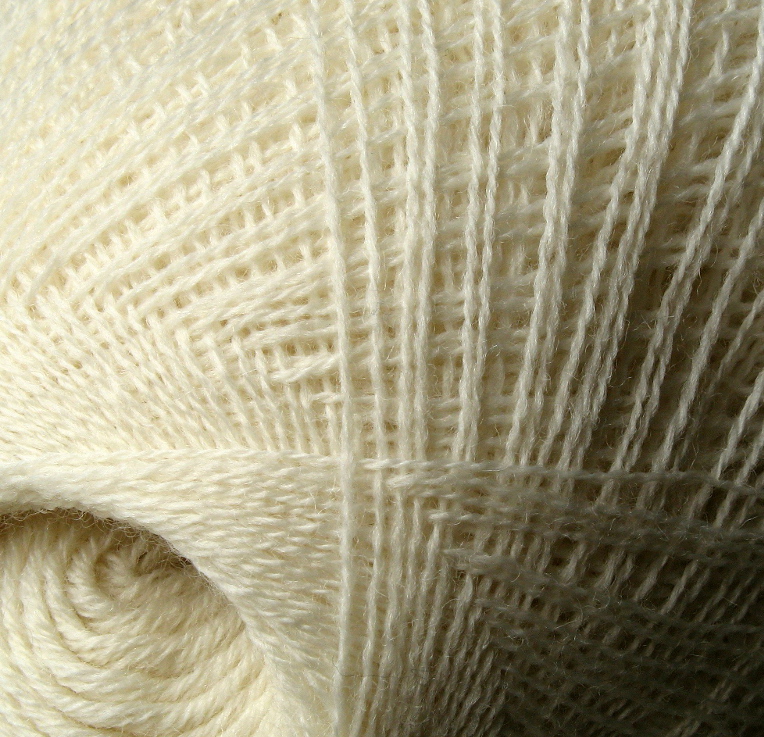
Knitting the centre part was very enjoyable, but all the finishing from sewing to gathering the edge stitches after blocking - not my favourite pastime at all.

The stitch pattern used is Karukellakiri (Pasqueflower pattern), I like its varied texture. Made four pattern repeats in width and 19 lengthwise to obtain the standard size, but the shawl seems a bit small. Rinsing with cold water might have been a mistake, this made the wool stretch significantly less on the blocking frame.

The seam is not quite perfect, there are some occasional larger spaces in it. These are probably caused by looser edge stitches, next time I will focus harder on the end stitches of every row and pull them more tightly around the needle, maybe that will do the trick.
This made me a little unhappy first, but I'm sure nobody will notice it while the shawl is worn. Besides, I discovered that the seams look similar in the Haapsalu Shawl book (blocking frame photos).

The yarn used for the shawl is Midara Micro in natural white (shade No. 025, pure wool). Not the easiest lace yarn to knit, because it's not very smooth and tends to dangle easily, but ripping it was quite possible - had to try this a little along the road. Perhaps the yarn is not quite thin enough either, but the result seems fine and the shawl has a better hold than those knitted with merino wool.


OMG, amazing Shawl , so beautiful :)
ReplyDeletecongrats from Paris :)
Mademoisellealex
Congratulations. It turned out beautifully! The finishing is really the most tedious part of a shawl. I have tried to open up the loops of the cast on edge after blocking once but it did not look so pretty. I like the more "braided" look of the cast on edge although it is not traditional then. But maybe one day, I will be brave enough to try it again. I do not see what you do not like about your seam. I totally agree with you on the Midara Micro. It holds its shape very well. It is not overly soft but it is not too scratchy either in my opinion. But I dream of knitting a shawl with much thinner wool some day.
ReplyDeleteImekena!
ReplyDeletePole siin miskeid auke servades näha, kõik on täpselt nii kuis peab. Kas põhiosa kudusid nr 3 ja äärepitsi 3,5 varrastega?
Meeli
Thank you all for the nice words! The close-up picture of the seam only shows a 'nice' part, naturally. I suppose, it's not really a problem, just something to give more attention to next time.
ReplyDeleteAitäh! Aukudest pole muidugi lähivõtet välja riputatud, aga ega keegi neid vist kaugemalt tõesti märka. Ainult mul endal on tekkinud erihuvi teiste inimeste sallide õmblused üle vaadata.
Kudusin varrastega 2,75 ja 3,25, tundus ilusam, aga eks seetõttu on ka vähem venitatav.
And what needle size did you use for opening up the cast-on edge? Every time, I am trying it, I fear to damage the edge somehow ...
ReplyDeleteDo you mean casting on with a different yarn?
ReplyDeleteI don't do that, I use the knitted cast-on like described in the book - making stitches onto the left needle (5 mm), almost like crocheting.
Yes, that is what I do, too.
ReplyDeleteI mean after blocking. I understood that you opened up the loops of the outer edge with a needle, didn't you? "gathering the edge stitches after blocking"? And if you did that, what needle size did you use?
Oh I see now... I just used the long needles I had, 2.5 and 3 mm, seem to have been thick enough. The scallops were perhaps a little out of shape afterwards, but nothing happened to the edge.
ReplyDeleteSo beautiful!!!!
ReplyDeleteThank you!
Delete